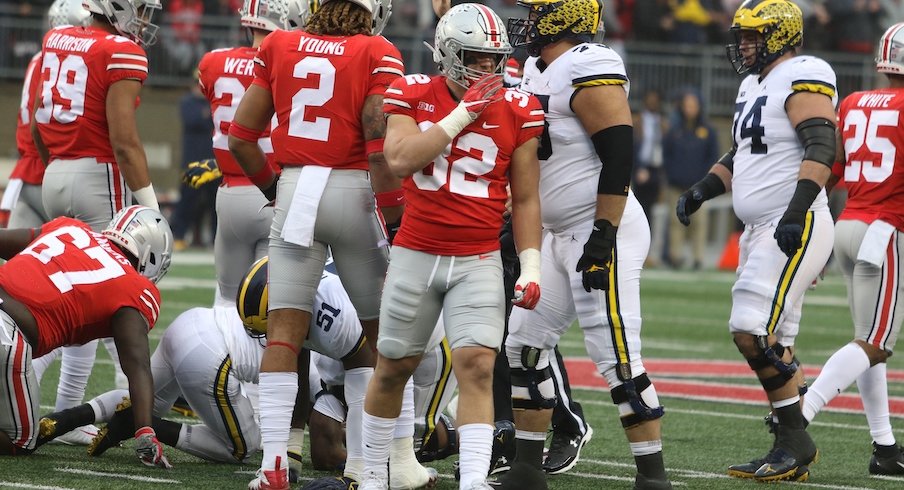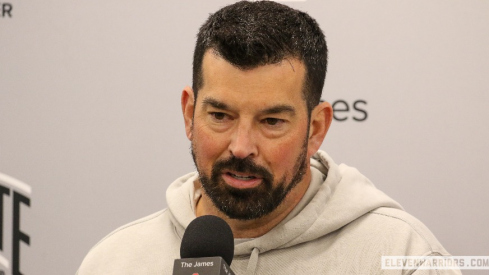If you grew up in the state of Ohio, the Ohio State-Michigan rivalry has probably been a big part of your life since you were a kid.
That wasn’t the case for any of the six Buckeyes who represented the Ohio State football team during its rivalry-week press conference on Tuesday.
Ryan Day grew up in New Hampshire, where the biggest sports rivalries in his life as a kid were Red Sox vs. Yankees and Celtics vs. Lakers. Wyatt Davis and Chris Olave grew up in California, while Tuf Borland is from Illinois, Pete Werner is from Indiana and Jordan Fuller is from New Jersey.
They didn’t necessarily understand what the rivalry meant to the Ohio State football program and its fans before they became Buckeyes, but they certainly do now.
It didn’t take long to figure that out once they arrived in Columbus.
“To see what this means to the people of Ohio and the Buckeye Nation, that's to me where it really hits home,” Day said. “The Ohio State football team means everything to the people of Ohio. It runs deep in their blood, and it's who they are, it's their identity, it’s their pride. And to be the head coach of the football team, that's just an unbelievable responsibility and that's why we stay late at night, we come early in the morning and make sure we do everything we can to make sure we're successful in this game because it means so much to so many people.”
While Ohio State has won its first 11 games of the season, has already clinched the Big Ten East and is on the cusp of earning a berth in the College Football Playoff, Day and the Buckeyes know their season will be defined as much by what happens in Saturday’s regular-season finale against Michigan as anything else they accomplish this year.
To some Ohio State fans, beating Michigan means more than even the chance to compete for a national championship. That’s how much the rivalry means in the state of Ohio, so the Buckeyes know they need to be prepared to play their best game of the year this weekend.
“This game means everything to us,” Day said. “Nothing matters if we don't win this game.”
For some Ohio State players, the opportunity to represent the Buckeyes in the rivalry is a big reason why they choose to become Buckeyes in the first place. That’s certainly the case for many of the 60 players on Ohio State’s roster who are from Ohio, along with others who grew up as Ohio State fans.
Some of the Buckeyes’ biggest stars aren’t from Ohio, though, and didn’t necessarily comprehend the year-round obsession that Buckeye fans have with beating the Wolverines. Olave admitted Tuesday that when he arrived at Ohio State, he “didn’t really think that was going to be a huge deal,” but he quickly learned otherwise.
“It was the first day I stepped on campus,” Olave said. “Everybody was talking about it. I believe we had a workout that day, and we had to do Team Up North abs – which is like after a workout, we do how many days counting down, that’s how many abs we got to do for that day – and that’s when I first heard of the rivalry.”
Davis first learned how seriously Ohio State took the rivalry when he showed up at the Woody Hayes Athletic Center on a recruiting visit wearing a blue tank top, which was a big no-no at the football facility under former Buckeyes coach Urban Meyer. A staff member told Davis to put on a jacket to cover up the forbidden color, but that didn’t save him from getting his first rivalry-driven lecture.
“I guess word got to Coach Meyer, and I had the jacket on; he unzipped it and he was like, ‘Do you have that ugly color on?’ And I was like, ‘Yeah.’ He said, ‘Don't ever do that again,’” Davis recalled. “That made me realize that, you know, this is real. This is, it's very historic and we take that very serious around here.”
Werner didn’t grow up as a big fan of any particular college football team, but he did learn about the rivalry before he enrolled at Ohio State – so much so that it actually swayed his decision to become a Buckeye. That education came at the 2016 edition of The Game, when Werner – a Notre Dame commit at the time – was inside Ohio Stadium for the double-overtime thriller that ended with Curtis Samuel scoring the game-winning touchdown.
He decommitted from Notre Dame just three days later, having decided that he wanted to have the opportunity to play in the rivalry and represent the Buckeyes himself.
“I saw Curtis Samuel run that ball in the end zone, and that kind of brought me here,” Werner said. “I saw that and I was like, ‘Whoa, are you kidding me. I gotta come here.’ … I remember talking to Urban Meyer after the game, and it sold me from there.”
“To see what this means to the people of Ohio and the Buckeye Nation, that's to me where it really hits home.”– Ryan Day on the rivalry
All of that said, there’s nothing that makes an Ohio State player understand what it means to play in The Game more than strapping on a silver helmet, with a scarlet stripe down the middle and Buckeye Leaves on the side, and taking the field against the maize and blue for the first time.
“Obviously it’s ingrained in you the moment you walk on campus. Until you actually play in that game, that’s when you kind of understand kind of what this rivalry means to not only the people in this facility but throughout the whole state of Ohio, around the country,” Borland said. “Coming in here, you have no idea what this means. Until you actually play in the game and gain some experience and then you kind of gain some insight on what this means.”
All of those players were educated on the importance of the rivalry for at least one year by Meyer, who prioritized the rivalry above all else as Ohio State’s coach. Because Day didn’t grow up on the rivalry the same way as Meyer, who grew up as a Buckeye fan in Ashtabula, Ohio, there are understandably questions about whether the rivalry will be ingrained in Day’s teams the same way it was in Meyer’s teams, which won all seven of their games against the Wolverines.
Day learned from Meyer for two years as an assistant coach, though, and he understands from even his own background how defining a storied rivalry can be for a sports team and its fans.
“When somebody wears a Red Sox hat back home, that’s who you are, and certainly can relate that to everybody who grew up in the state of Ohio and put the block O on,” Day said.
Because of that, Day insists that the rivalry-driven culture that Meyer built at Ohio State – as the likes of Jim Tressel and Woody Hayes did before him – isn’t going anywhere. Beating the team to the north will continue to be on the Buckeyes’ minds 365 days a year and in everything they do, from the football field to the weight room to the recruiting trail, and he’ll make sure that everyone who wants to be a part of the Ohio State football program – no matter where they’re from – understands what the rivalry means, too.
“You get here, you start to live it every day and you understand it. Coach Meyer certainly talked about it all the time, and I’ve learned that way,” Day said. “And then being in The Game twice (as an assistant coach), the respect that I have for the rivalry is off the charts. It's one of the reasons that makes it so special to be at Ohio State.”


